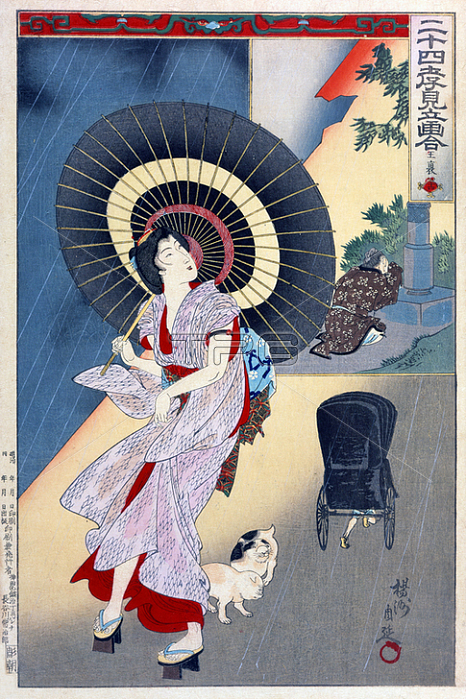
Wangpou was so diligent about calming his mother's fear of lightning that even after her death; he would go to her tomb during a rainstorm to comfort her. By contrast; this modern woman; caught in a summer downpour; seems unconcerned by the thunder. To further emphasize the contemporary setting; Chikanobu includes a rikshaw; a new mode of transportation in 19th century Tokyo (1890).
Toyohara Chikanobu (????) (1838-1912); better known to his contemporaries as Yoshu Chikanobu (????); was a prolific woodblock artist of Japan's Meiji period. His works capture the transition from the age of the samurai to Meiji modernity.
In 1875 (Meiji 8); he decided to try to make a living as an artist. He travelled to Tokyo. He found work as an artist for the Kaishin Shimbun. In addition; he produced nishiki-e artworks. In his younger days; he had studied the Kano school of painting; but his interest was drawn to ukiyo-e.
Like many ukiyo-e artists; Chikanobu turned his attention towards a great variety of subjects. His work ranged from Japanese mythology to depictions of the battlefields of his lifetime to women's fashions. As well as a number of the other artists of this period; he too portrayed kabuki actors in character; and is well-known for his impressions of the mie (formal pose) of kabuki productions.
Chikanobu was known as a master of bijinga; images of beautiful women; and for illustrating changes in women's fashion; including both traditional and Western clothing. His work illustrated the changes in coiffures and make-up across time. For example; in Chikanobu's images in Mirror of Ages (1897); the hair styles of the Tenmei era; 1781-1789 are distinguished from those of the Keio era; 1865-1867.
| px | px | dpi | = | cm | x | cm | = | MB |
Details
Creative#:
TOP20147349
Source:
達志影像
Authorization Type:
RM
Release Information:
須由TPG 完整授權
Model Release:
No
Property Release:
No
Right to Privacy:
No
Same folder images:

 Loading
Loading